|
| |
Archives
|
Saturday December 22 2007
|
give us this day our daily photograph

Popcorn & Lemonade, Seattle Center 1974
bigger
gordy's image archive index
In 1974 I was getting into photography pretty seriously. I bought a 6x7cm Koni-Omegaflex M (also here) as my first medium format camera. It was a giant twin lens reflex. A two handed beast. I really did like that camera. I think this picture was from my first or second roll ever of medium format color film. You can see me in the reflection behind the ampersand and the L. This was the only print I sold back then. I'm working on making another for my sister Madelane who is responsible for hooking me up with Don who bought the printer for me to use. I need to cleen up a few scratches. I'll be printing it 11x14 on 13x19 paper. I printed an 8x10 proof print on Epson Premium Luster. Wow! Color printing has come a long way. I'm liking the Epson 3800 more and more. Now if I only had the time to print with it more. After Christmas.
economy
Food Pantries Turning People Away as Demand Doubles
Food pantries are seeing a growing tide of people they've never before had to assist, many of whom work full-time jobs. The poverty in America that this crisis reveals is a national disgrace.
|
From the New York Times, we hear today that food pantries in Connecticut are turning the hungry away:
Amid this holiday season, food pantries in lower Connecticut are reporting a surge in the number of residents seeking a decent meal.
...
"I have had to turn people away," said Joyce Gumbus, who oversees the 164 Wilson Memorial Food Pantry in Stamford. The pantry is providing groceries for up to 400 people a week, compared with 200 a week last year, Ms. Gumbus said.
...
For the Food Bank, the clearinghouse for some of the pantries’ food, that translates into some difficult challenges, like providing Thanksgiving turkeys for 6,000 families this year, versus 3,000 in 2006. It means handling about 500 tons of food annually, 161,000 pounds of which were distributed in November alone, Ms. Lombardo said. "The need has doubled in the last year," she said. "And we don’t expect it to get better anytime soon."
And on Long Island, there are fears that donations are not adequately keeping up with the spike in demand:
Long Island Cares / the Harry Chapin Food Bank and Island Harvest, a food rescue group, are reporting a 42 percent increase in demand for food over last year among some of the nearly 800 nonprofit community groups they serve.
...
Nearly half of emergency food aid recipients on Long Island come from households with at least one employed adult, according to a 2006 study by America's Second Harvest Network. More than half are women.
And donations are not keeping pace with need. Island Harvest is predicting a food shortage of more than 195,000 meals by year's end.
It's not just the New York area. Its the same all over.
| |
[more]
photography
Shorpy
The 100-Year-Old Photo Blog
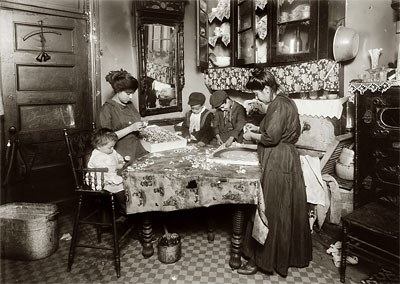
|
December 1911. Family of Mrs. Mette making flowers in a very dirty tenement, 302 Mott Street, top floor. Josephine, 13, helps outside school hours until 9 P.M. sometimes. She is soon to be 14 and expects to go to work in an embroidery factory. Says she worked in that factory all last summer. Nicholas, 6 years old and Johnnie, 8 yrs. The old work some. All together earn only 40 to 50 cents a day. Baby (20 months old) plays with the flowers, and they expect he can help a little before long. The father drives a coach (or hack) irregularly.
Photo and caption by Lewis Wickes Hine.
| |
[more]
thanks to 2point8
A lot of great old photos with large versions.
book recommendation

The Lucifer Effect:
Understanding How Good People Turn Evil
by Philip Zimbardo
The Lucifer Effect revolves around a very interesting psychology experiment done at Stanford, in 1971, known as the Stanford Prison Experiment. Zimbardo took perfectly normal students and arbitrarily assigned them as prisoners and guards and made a prison in the basement of a Stanford building. Things quickly got out of hand. The guards started abusing the prisoners and the prisoners, who could have quit the experiment, acquiesced. Even those running the experiment got sucked in and it took Zimbardo's girlfriend to finally make him aware of the abuse and to end the experiment early. The book's first part goes into the details of the actual experiment. Then he draws conclusions. His point is that, contrary to your favorite bible thumper, there aren't evil people and good people. It depends on the situations we are put in. We all have the capability of doing terrible things under the right situation. Zimbardo then looks at how this has played out in real life at Abu Ghraib, which was the Stanford Prison Experiment writ large. The guards at Abu Ghraib didn't have a chance. The Lucifer Effect is a must read. Aside from the book there are also web resources that cover this landmark experiment.
The Lucifer Effect
|
Welcome to LuciferEffect.org, official web site of The Lucifer Effect: Understanding How Good People Turn Evil (Random House, 2007). In this book, I summarize more than 30 years of research on factors that can create a "perfect storm" which leads good people to engage in evil actions. This transformation of human character is what I call the "Lucifer Effect," named after God's favorite angel, Lucifer, who fell from grace and ultimately became Satan.
Rather than providing a religious analysis, however, I offer a psychological account of how ordinary people sometimes turn evil and commit unspeakable acts. As part of this account, The Lucifer Effect tells, for the first time, the full story behind the Stanford Prison Experiment, a now-classic study I conducted in 1971. In that study, normal college students were randomly assigned to play the role of guard or inmate for two weeks in a simulated prison, yet the guards quickly became so brutal that the experiment had to be shut down after only six days.
| |
[more]
Stanford Prison Experiment
|
Welcome to the Stanford Prison Experiment web site, which features an extensive slide show and information about this classic psychology experiment, including parallels with the abuse of prisoners at Abu Ghraib. What happens when you put good people in an evil place? Does humanity win over evil, or does evil triumph? These are some of the questions we posed in this dramatic simulation of prison life conducted in the summer of 1971 at Stanford University.
| |
[more]
Stanford prison experiment
From Wikipedia, the free encyclopedia
|
The Stanford prison experiment was a psychological study of human responses to captivity and its behavioral effects on both authorities and inmates in prison. It was conducted in 1971 by a team of researchers led by Philip Zimbardo of Stanford University. Undergraduate volunteers played the roles of both guards and prisoners living in a mock prison in the basement of the Stanford psychology building.
Prisoners and guards rapidly adapted to their roles, stepping beyond the boundaries of what had been predicted and leading to dangerous and psychologically damaging situations. One-third of the guards were judged to have exhibited "genuine" sadistic tendencies, while many prisoners were emotionally traumatized and two had to be removed from the experiment early.
Ethical concerns surrounding the famous experiment often draw comparisons to the Milgram experiment, which was conducted in 1961 at Yale University by Stanley Milgram, Zimbardo's former high school friend.
Tom Peters and Robert H. Waterman Jr wrote in 1981 that the Milgram Experiment in the 1960s and the later Zimbardo Experiment were frightening in their implications about the danger which lurks in the darker side of human nature.
| |
[more]
more flickr sets
I think my lensboard building frenzy is over for the moment. I still need to mount the Ektar 127 but I'll wait until the shutter is fixed. I also need to mount the shutter for the pinhole but I don't have the pinhole yet. And then there are the boards for the 5x7. Next year. I wanted to capture some of what I learned and Flickr is an easy way to do it.

Making lensboards
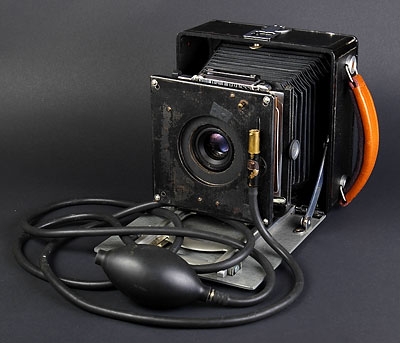
Mounting a Packard shutter
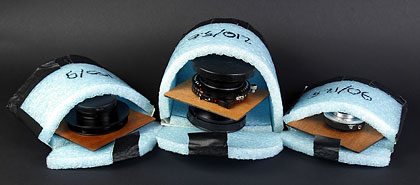
Lens shelters
iraq
I haven't posted on Iraq for a while. The only good news, for my family, coming out of Iraq is that my son-in-law William is leaving Baghdad on the 28th to return home.
Will Iraq's Great Awakening Lead to a Nightmare?
|
American casualties in Iraq have declined dramatically over the last 90 days to levels not seen since 2006, and the White House has attributed the decline to the surge of 35-40,000 U.S. combat troops. But a closer look suggests a different explanation. More than two years of sectarian violence have replaced one country called Iraq with three emerging states: one Kurdish, one Sunni, and one Shiite. This created what a million additional U.S. troops could not: a strategic opportunity to capitalize on the Sunni-Shiite split. So after Shiite leader Muqtada al-Sadr decided to restrain his Mahdi army from attacking U.S. forces, General David Petraeus and his commanders began cutting deals with Sunni Arab insurgents, agreeing to allow these Sunnis to run their own affairs and arm their own security forces in return for cooperation with U.S. forces against Al Qaeda fighters. As part of the bargain, the Sunni leaders obtained both independence from the hated Shiite-dominated government, which pays far more attention to Tehran's interests than to Washington's, and money—lots of money.
Striking such a "sheikhs for sale" deal (whether they be Sunni or Shiite) is nothing new in the Arab world. The men who ran the British Empire routinely paid subsidies in gold to unruly tribal leaders from the Khyber Pass to the headwaters of the Nile. (Of course, British subsidies were a pittance compared with the billions Britain extracted from its colonies in Africa and Asia.) While the arrangement reached by U.S. military commanders and dubbed the "Great Awakening" has allowed the administration and its allies to declare the surge a success, it carries long-term consequences that are worrisome, if not perilous. The reduction in U.S. casualties is good news. But transforming thousands of anti-American Sunni insurgents into U.S.-funded Sunni militias is not without cost. In fact, the much-touted progress in Iraq could lead to a situation in which American foreign-policy interests are profoundly harmed and the Middle East is plunged into even a larger crisis than currently exists.
| |
[more]
thanks to daily KOS
Bush Negotiates Permanent Presence in Iraq
Operation Iraqi Freedom Exposed
|
The revelation that Bush will sign an agreement for a permanent U.S. military presence in Iraq before his term is up confirms the real reason he invaded Iraq and changed its regime.
It was never about weapons of mass destruction. It was never about ties between Saddam and al Qaeda. And it was never about bringing democracy to the Iraqi people. These claims were lies to cover up the real motive for Operation Iraqi Freedom: to create a permanent American presence in Iraq. With Bush's November 26, 2007 announcement that the United States and Iraq were negotiating a permanent "security relationship," his lies have been exposed.
| |
[more]
Tomgram: Michael Schwartz, Why Bush Won't Leave Iraq
|
The briefing seemed uneventful -- very much a reflection of the ongoing mood of the moment among American commanders in Iraq -- and received no significant media coverage. However, there was news lurking in an answer Col. Bannister gave to a question from AP reporter Pauline Jelinek (about arming volunteer local citizens to patrol their neighborhoods), even if it passed unnoticed. The colonel made a remarkable reference to an unexplained "five-year plan" that, he indicated, was guiding his actions. Here was his answer in full:
"I mean, right now we're focused just on security augmentation [by the volunteers] and growing them to be Iraqi police because that is where the gap is that we're trying to help fill capacity for in the Iraqi security forces. The army and the national police, I mean, they're fine. The Iraqi police is -- you know, the five-year plan has -- you know, it's doubling in size. … [We expect to have] 4,000 Iraqi police on our side over the five-year plan.
"So that's kind of what we're doing. We're helping on security now, growing them into IP [Iraqi police]…. They'll have 650 slots that I fill in March, and over the five-year period we'll grow up to another 2,500 or 3,500.
Most astonishing in his comments is the least astonishing word in our language: "the." Colonel Bannister refers repeatedly to "the five-year plan," assuming his audience understands that there is indeed a master plan for his unit -- and for the American occupation -- mandating a slow, many-year buildup of neighborhood-protection forces into full fledged police units. This, in turn, is all part of an even larger plan for the conduct of the occupation.
| |
[more]
Iraq as a Pentagon Construction Site
How the Bush Administration "Endures"
|
The title of the agreement, signed by President Bush and Iraqi Prime Minister Maliki in a "video conference" last week, and carefully labeled as a "non-binding" set of principles for further negotiations, was a mouthful: a "Declaration of Principles for a Long-Term Relationship of Cooperation and Friendship Between the Republic of Iraq and the United States of America." Whew!
Words matter, of course. They seldom turn up by accident in official documents or statements. Last week, in the first reports on this "declaration," one of those words that matter caught my attention. Actually, it wasn't in the declaration itself, where the key phrase was "long-term relationship" (something in the lives of private individuals that falls just short of a marriage), but in a "fact-sheet" issued by the White House. Here's the relevant line: "Iraq's leaders have asked for an enduring relationship with America, and we seek an enduring relationship with a democratic Iraq." Of course, "enduring" there bears the same relationship to permanency as "long-term relationship" does to marriage.
| |
[more]
Pentagon Cover Up:
15,000 or more US casualties in Iraq War
|
The Pentagon has been concealing the true number of American casualties in the Iraq War. The real number exceeds 15,000 and CBS News can prove it.
CBS’s Investigative Unit wanted to do a report on the number of suicides in the military and “submitted a Freedom of Information Act request to the Department of Defense”. After 4 months they received a document which showed--that between 1995 and 2007--there were 2,200 suicides among “active duty” soldiers.
Baloney.
The Pentagon was covering up the real magnitude of the “suicide epidemic”. Following an exhaustive investigation of veterans’ suicide data collected from 45 states; CBS discovered that in 2005 alone “THERE WERE AT LEAST 6,256 AMONG THOSE WHO SERVED IN THE ARMED FORCES. THAT’S 120 EACH AND EVERY WEEK IN JUST ONE YEAR.”
That is not a typo. Active and retired military personnel, mostly young veterans between the ages of 20 to 24, are returning from combat and killing themselves in record numbers. We can assume that "multiple-tours of duty" in a war-zone have precipitated a mental health crisis of which the public is entirely unaware and which the Pentagon is in total denial.
| |
[more]
Study: 1 Out of 4 Homeless Are Veterans
|
Veterans make up one in four homeless people in the United States, though they are only 11 percent of the general adult population, according to a report to be released Thursday.
| |
[more]
US soldiers shy from battle in Iraq
|
Iraq war veterans now stationed at a base here in upstate New York say that morale among US soldiers in the country is so poor, many are simply parking their Humvees and pretending to be on patrol, a practice dubbed "search and avoid" missions.
| |
[more]
thanks to Yolanda Flanagan
commie christmas
Old Soviet Christmas card collection

[more]
thanks to Neatorama
america the beautiful
Iceland complains about treatment of tourist
Woman arrested at JFK for overstaying U.S. visa more than a decade earlier
|
Iceland's government has asked the U.S. ambassador to explain the treatment of an Icelandic tourist who says she was held in shackles before being deported from the United States.
The woman, Erla Osk Arnardottir Lillendahl, 33, was arrested Sunday when she arrived at JFK airport in New York because she had overstayed a U.S. visa more than 10 years earlier.
| |
[more]
thanks to Yolanda Flanagan
LOST
|
During the last twenty-four hours I have probably experienced the greatest humiliation to which I have ever been subjected. During these last twenty-four hours I have been handcuffed and chained, denied the chance to sleep, been without food and drink and been confined to a place without anyone knowing my whereabouts, imprisoned. Now I am beginning to try to understand all this, rest and review the events which began as innocently as possible.
| |
[more]
thanks to Yolanda Flanagan
lens boards
I've been busy cranking out lens boards for my Burke & James Press.

Konica Hexanon GRII 150mm/f9
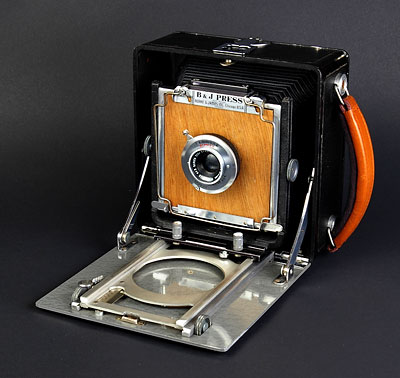
Wollensak 4x5 Series IIIA EX.W.A. 90mm f/12.5
I have a Flickr set with all the lenses: Burke & James Press Lenses
I have the field lenses mounted: the 210, 150, and 90. One hand held lens mounted, the Wollensak 90/4.5. One hand held lens to mount when it's repaired: the 127 Ektar. Both hand held lenses are flash synched. Next mounted will be the pinhole shutter. I'm more than happy on how they are coming out. More Flickr sets to follow.
|
Wednesday December 19 2007
|
israel/palestine
After Annapolis
"The Tumult and the Shouting Dies ... "
|
"THE TUMULT and the shouting dies, / The captains and the kings depart" Rudyard Kipling wrote in his unforgettable poem "Lest We Forget" ("Recessional")
King George departed even before the tumult had died. His helicopter carried him away over the horizon, just as his trusty steed carries the cowboy into the sunset at the end of the movie. At that moment, the speeches in the assembly hall were still going ahead at full blast.
This summed up the whole event. The final statement announced that the United States will supervise the negotiations, act as a referee of the implementation and as a judge throughout. Everything depends on her. If she wants it - much will happen. If she does not want it - nothing will happen.
That bodes ill. There is no indication that George Bush will really intervene to achieve anything, apart from nice photos. Some people believe that the whole show was put on to make poor Condoleezza Rice feel good, after all her efforts as Secretary of State have come to nought.
Even if Bush wanted to, could he do anything? Is he capable of putting pressure on Israel, in the face of vigorous opposition from the pro-Israel lobby, and especially from the Christian-Evangelist public, to which he himself belongs?
A friend told me that during the conference he watched the televised proceedings with the sound turned off, just observing the body language of the principal actors. That way he noticed an interesting detail: Bush and Olmert touched each other many times, but there was almost no physical contact between Bush and Mahmoud Abbas. More than that: during all the joint events, the distance between Bush and Olmert was smaller than the distance between Bush and Abbas. Several times Bush and Olmert walked ahead together, with Abbas trailing behind.
That's the whole story.
| |
[more]
Omar Barghouti: "No State Has the Right to Exist as a Racist State"
|
Silvia Cattori: The fact remains that «anti-Semite» has a much stronger impact than «racist», because in many countries of Europe, there legal are consequences for those who are accused of being « anti-Semitic ». Should we not be considered equal, Jews and non-Jews? Why should we accept this biased way of making people feel guilty about something that does not exist any more, but proves to be very useful for pro-Israeli war propaganda purposes?
Omar Barghouti: Yes, we should fight that, too. There has to be a struggle to reject all racism equally and not to accept current European laws that treat anti-Semitism as a separate class of crime, far worse than any other form of racism, including Islamophobia or anti-black racism, arguably the most prevalent expressions of white racism nowadays.
These laws are themselves discriminatory. Anti-Semitism is just another form of racism, no more, no less; it should be treated as one branch of racism, not a super branch. But, in any case, it does not justify Israel’s racist nature; it cannot justify Israel’s crimes. We should decouple anti-Semitism from anti-Zionism. While the former is a form of racism; the latter is a moral stance against racism.
Silvia Cattori: But this will not be possible as long as Palestinians find themselves in a situation of inequality, and that the oppressed people can’t tell us how they live. Instead, those who play the game of «normalization» have the stage, which is a kind of collaboration!
Omar Barghouti: Palestinian representatives ought to respect and unite behind our civil society’s BDS call for a struggle against the three key forms of Israeli injustice, not just one – occupation and colonisation of the 1967 territory is just one form of injustice.
The core of the question of Palestine remains the much larger injustice, the denial of the basic rights of the refugees, who constitute the majority of the Palestinian people.
And there is a third form of injustice, which is often overlooked – the regime of institutionalized racism against Palestinian citizens of Israel. Even if Israel ended the occupation tomorrow, it will not end this colonial conflict. The solidarity movement in Europe and the rest of the world has to respect the genuine voice of Palestinian civil society, rather than promote Palestinian quislings or little bureaucrats who tour the world to say anything as long as they are paid well. They do not represent the Palestinian people; they do not speak on behalf of the Palestinians.
| |
[more]
My god, what did we do?
|
One night, Tamar Yarom was awakened by one of the soldiers in her unit. He said he wanted to show her something in the basement of the abandoned building where they were staying. "Before we opened the door, I heard this awful noise from a generator and there was a strong smell of diesel fuel. I saw a middle-aged Palestinian detainee lying with his head on the generator. His ear was pressed against the generator that was vibrating, and the guy's head was vibrating with it. His face was completely messed up. It amazed me that through all the blood and horror, you could still see the guy's expression and that's what stayed with me for years after - the look on his face."
| |
[more]
book recommendation

André Kertész:
The Polaroids
by André Kertész
André Kertész is a photographer that provides continual inspiration. I was fortunate to purchase a Kertész print, Fortune Teller, in the mid 1970s. It would be impossible now. This is a book of Polaroid photographs taken at the end of his life. Amazing photographs and an amazing story behind them.
The Polaroids
|
André Kertész (1894 – 1985) had a brilliant but insecure start in Hungary (1912 – 1925), found fame in Paris (1925 – 1936), survived a catastrophic commercial and artistic period in New York (1936 - 1962), and enjoyed a professional rebirth in the early 70s. However, following the loss of his wife Elizabeth to lung cancer in 1977, and nearing the end of his own life, Kertész was admittedly a broken man.
Alone and in New York, a city in which he never felt fully embraced, Kertész would once again retreat into the safe confines of his Fifth Avenue apartment overlooking Washington Square Park. Fortunately, it was the inspiration found in a small glass bust, discovered in the window of a local bookshop, whose figure reminded him of his late wife, which would trigger the artist’s remarkable recovery process. The resultant body of work is now the focus of this unique exhibition.
Turning to a relatively new technology, the Polaroid SX-70, Kertész worked through his overwhelming grief, obsessively shooting the bust alone and placing it among other artifacts he and Elizabeth had collected together over the years. Taken from within his apartment, he photographed many of these still-lifes by placing personal objects against cityscape backgrounds, which were often reflected and modulated by glass surfaces.
Throughout his career, Kertész experimented with overlapping themes and ideas. His approach here is no different. It is in these Polaroids where he resurrects and reworks old ideas and concepts, and explores new ones generated by his reaction to this special camera itself. They are powerful metaphorical and literal symbols of life, love, loss, death and mortality.
In the years following Elizabeth’s death, until his own in 1985, André Kertész continued to photograph and exhibit work, solidifying his stature as an artist of world rank.
| |
[more]
André Kertész: The Polaroids
 [more] [more]
André Kertész
It's these Polaroids that have me wanting an SX-70.
russia
Putin Agonistes: Missile Defense will not be Deployed
|
It's been a lot of hard work, but Russian President Vladimir Putin has finally achieved his goal. He's cleaned up the mess left behind by Yeltsin, put together a strong and thriving economy, and restored Russia to a place of honor among the community of nations. His legacy has already been written. He's the man who rebuilt Russia. The last thing he wants now, is a pointless confrontation with the United States. But how can it be avoided? He understands Washington's long-range plans for Russia and he is taking necessary steps to preempt them. He is familiar with the heavyweights of US foreign policy, like Zbigniew Brzezinski, and has undoubtedly read his master-plan for Central Asia, “The Grand Chessboard”. Brzezinski's recent article in Foreign Affairs, (A publication of the Council on Foreign Relations) “A Geostrategy for Eurasia” summarizes his views on America's future involvement in the region:
“America's emergence as the sole global superpower now makes an integrated and comprehensive strategy for Eurasia imperative.
Eurasia is home to most of the world's politically assertive and dynamic states. All the historical pretenders to global power originated in Eurasia. The world's most populous aspirants to regional hegemony, China and India, are in Eurasia, as are all the potential political or economic challengers to American primacy. ... Eurasia accounts for 75 percent of the world's population, 60 percent of its GNP, and 75 percent of its energy resources. Collectively, Eurasia's potential power overshadows even America's.
Eurasia is the world's axial supercontinent. A power that dominated Eurasia would exercise decisive influence over two of the world's three most economically productive regions, Western Europe and East Asia. A glance at the map also suggests that a country dominant in Eurasia would almost automatically control the Middle East and Africa. With Eurasia now serving as the decisive geopolitical chessboard, it no longer suffices to fashion one policy for Europe and another for Asia. What happens with the distribution of power on the Eurasian landmass will be of decisive importance to America's global primacy and historical legacy.”
So, there it is. The US is moving into the neighborhood and has no intention of leaving. The war on terror is a fraud; it merely conceals the fact that Bush is sprinkling military bases throughout Central Asia and surrounding Russia in the process. Brzezinski sees this as a “strategic imperative”. It doesn't matter what Putin thinks. According to Brzezinski “NATO enlargement should move forward in deliberate stages” . The US must make sure “that no state or combination of states gains the ability to expel the United States or even diminish its decisive role”.
This isn't new. Putin has known for some time what Bush is up to and he's been as accommodating as possible. After all, his real passion is putting Russia back on its feet and improving the lives of its citizens. That will have to change now that Bush has decided to install a “Missile Defense” system in Eastern Europe. Putin will have to devote more time to blocking America's plans. The new system will upset the basic balance of power between the nuclear rivals and force Putin to raise the stakes. A confrontation is brewing whether Putin wants it or not. The system cannot be deployed. Period. Putin must now do whatever he is necessary to remove a direct threat to Russia's national security. That is the primary obligation of every leader and he will not shirk his responsibility.
| |
[more]
photography
This is an interview with one of my favorite photogrphers.
Joel Meyerowitz Interview (Part 1)
|
2point8: You have your Cape Light era pictures up at Jackson Fine Art, and I’m curious as to what the transition was like for you, from your earlier street work, to the large format photographs on Cape Cod? Were you finding limitations in the 35mm work? Did you want to step back, take more in, and describe as clearly as possible what you were seeing?
MEYEROWITZ: That’s exactly, precisely what it was for me. In that particular period of the 70s, when John Szarkowski was at MOMA, some of the underlying themes of his philosophy dealt with description. Description was what photography did - first and foremost. You press the button and the camera describes what it’s pointing at. That’s all it really does. It’s what you point it at, and how consistent you are, and how interesting you find subject matter that gives your work a dimension, and a shape, and a reason for being. But in the beginning, all the camera does is describe what’s in front of you. You can’t make it more than it is; it just is what it is.
I think my generation probably were influenced by this kind of thinking and expression, so I started making 35mm pictures that let go of the subject in the center of the picture, and I moved to a more overall take on things. And that led me, when I saw the space in that kind of photograph, to the view camera. I could make pictures of very deep space, and have incredible resolution all through the space. So I talked myself into working with the large format camera, to gain this description, but of course I lost a certain amount of mobility in the exchange. The hybrid was interesting to me, because I tried to keep the camera like the 35mm - open and ready for use, rather than packed-up in a box, and I worked as quickly as I could. So, that, in a sense is what the difference is, and I’ve always felt that all the years I spent out on the street were very instructive to me, when I became a large format photographer. Incredibly helpful really. And then I think that the work I did with the large format also illuminated for me new options with the 35mm. It re-seeded itself, it nourished me in a new way.
| |
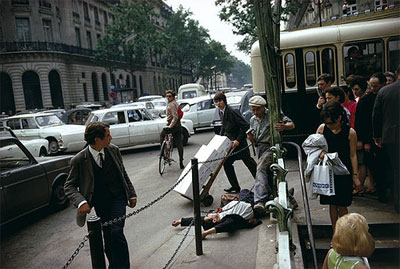
[more]
Joel Meyerowitz Interview (Part 2)
Three book recommendations of Joel Meyerowitz books: Cape Light: Color Photographs, Aftermath: World Trade Center Archive and Bystander: A History of Street Photography.
economy
Failure Beyond Finance
by Jim Kunstler
|
Events are driving us now, not personalities or even policies. Ben Bernanke, Hank Paulson, and the other characters in the headlines might pretend that they are managing things, but the truth is that problems in the financial sector have spun wildly out of control. The wheels are coming off and we are in that long sickening moment of sideways sliding motion when no attempt at steering will avail to avoid the crash. That it is happening at the very height of the Christmas season, when events have previously been controllable -- the season of manufactured Santa Claus rallies and $50 million bonuses -- shows how perilous the situation is.
The reason the financial sector is crashing is really pretty simple: it created too many fraudulent securities. What has been conspicuously absent so far is any sense of accountability for what may go down as history's greatest swindle. It's really impossible to imagine that a bunch of low-ranking worker bees in the banking hives spun out all these bundles of collateralized debt obligations, mortgage-backed securities, and similar trash on their own without the say-so of their bosses -- a group that includes the current Secretary of the Treasury, Mr. Paulson, formerly CEO of the Goldman Sachs organization. And, of course, the questions naturally follow: what about those in charge of the ratings agencies that awarded AAA status to high-risk junk investments; and where were the banking regulators when outfits like Countrywide Financial, Washington Mutual, and Ditech were handing out miracle mortgages to borrowers without normal qualifications; and where was the Securities and Exchange Commission when the wholesale trade in creatively-engineered debt instruments ramped up to high volume, and what was the board of directors at Merrill Lynch thinking when it allowed disgraced CEO Stan O'Neal to back a truck up to the company loading dock and fill it up with $160 million in bonus-and-termination payments after O'Neal presided over at least $8 billion in losses?
What we're also seeing is a crisis of authority on top of a crisis of capital, and it will probably lead to a crisis of legitimacy -- by which I mean a catastrophic loss of faith that this society can govern itself at any level. Leadership across the board has failed, in government, in business, in what used to be called the press, and in education. Leadership in every sector went along with the program, marveling stupidly at their society's ability to get something for nothing.
| |
[more]
christmas
WishbookWeb.com

[more]
family stuff
Zoe and I went down Sunday evening and brought dinner for Gerry. She is doing better although Zoe thought she has lost weight and was worried for her mom. Gerry ate well and that is the best we hope for at this point. We have increased our visits since she usually does eat well with us and the hope is that her eating will continue through the week until we return.
Saturday we went down to my brother Terry's for Thanksmas. There had been a revolt of a couple of daughter-in-laws that wanted to spend time with their families after years of Coale Thanksgivings and Christmases. It was decided that this year the Coales would get together on the 15th to celebrate Thanksgiving and Christmas. A turkey dinner and a Christmas tree. A good time was had by all. Unfortunately, Adam had to work and Roger had to leave early for work. Madelane and Hannah couldn't make it because they had colds and didn't want to expose mom, who is 87. But Madelane did send down this picture.
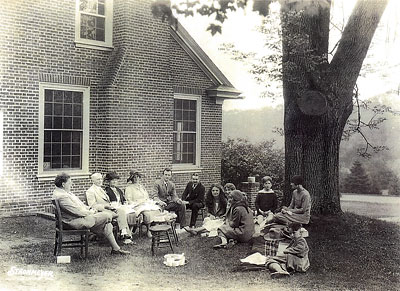
bigger
The picture is taken at Westtown, a Quaker boarding school my dad went to. The year is 1928. The individual on the far left is N.C. Wyeth. Sixth from the left is my grandfather Griffith Baily Coale. Madelane has been corresponding with Westtown looking for family information. Madelane called today to point out a page on the Westtown website: The Giant - A Westtown Treasure. I wish there was a larger verision of The Giant on the web. The largest I could find is this one. It's a wonderful painting. I didn't realize it belonged to Westtown.
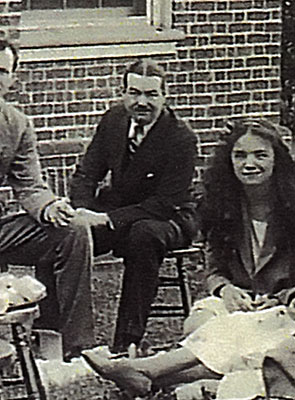
A crop of my grandfather.
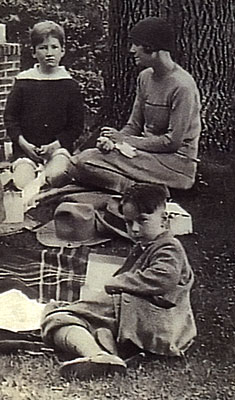
Althought they are not identified, Madelane thinks the boy on the right front is our dad. It sure looks like him. There is a definite family resemblance. He would turn 11 in August, 1928. Madelane also thinks the woman above him is our grandmother Madge.
Here is a story my dad told about his stay at Westtown. One spring a group of Westtown boys, including my dad, decided to make root beer. They used raisins, they were available, and poured the root beer mixture into bottles and capped them. Root beer needs to ferment so they pried up the floor boards of their room, above a classroom, and hid them their to ferment over the summer. The next fall they returned to classes and noticed that the classroom had a new ceiling. It turns out the one of the bottles exploded taking all the other bottles with it. A good Quaker education.
|
|
|
|

















